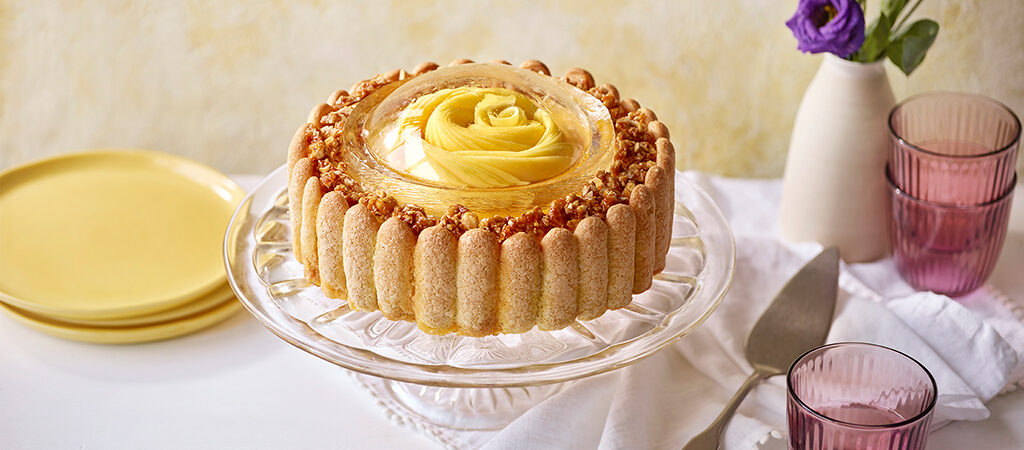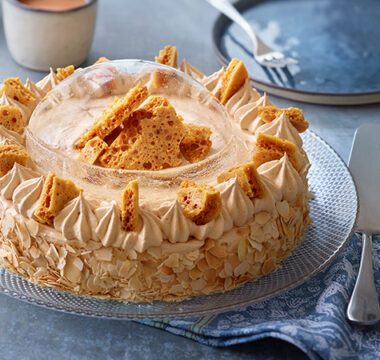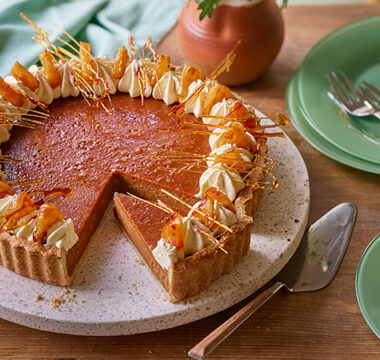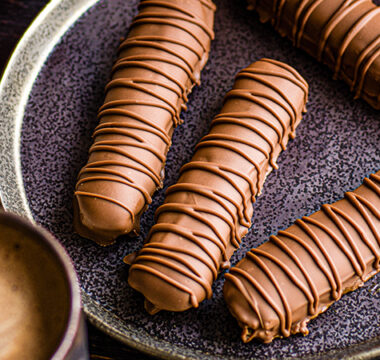Buttery shortcrust, crunchy praline, light chocolate sponge, rich caramel paired with vibrant mango and passion fruit, this is a truly impressive dessert masterpiece embellished with a sugar dome for that extra wow factor.


Jürgen
Series 12
- Ingredients
- Method
Method
Step 1
Heat the oven to 200°C/180°C fan/400°F/Gas 6.
Step 2
Make the shortcrust base. Tip the flour and butter into a food processor. Blitz until the mixture resembles breadcrumbs, then add the sugar and pulse to combine. Tip in the egg yolk and blitz until the mixture comes together to form a rough dough. Tip out the dough onto a lightly floured work surface, bring it together into a ball, then flatten it slightly.
Step 3
Place the dough between two sheets of baking paper and roll it into a disc roughly 3mm thick. Place the disc on a baking sheet, still between the sheets of baking paper, and chill it for 15 minutes.
Step 4
Meanwhile, make the hazelnut praline. Heat the sugar with 2 tablespoons of water in a heavy-based saucepan over a low heat, gently swirling the pan from time to time (but don’t stir), until the sugar dissolves.
Step 5
Increase the heat, bring the syrup to the boil and continue to cook, without stirring, until it turns an amber colour, then take the pan off the heat. Stir in the hazelnuts and then pour the molten praline onto a lined baking sheet. Cover the praline with another sheet of baking paper and, using a rolling pin, roll it out as thinly as possible. Leave it to cool completely before breaking it into small pieces.
Step 6
Remove the top sheet of baking paper from the chilled dough and, using the base of the 23cm cake tin as a guide, cut out a neat circle using a sharp, small knife. Discard the trimmings. Prick the dough disc all over with a fork, then bake it for 10 minutes, until lightly golden. Leave to cool.
Step 7
Meanwhile, make the chocolate genoise. Put the eggs and sugar in a large heatproof bowl set over a pan of barely simmering water. Whisk with an electric hand whisk for about 3 minutes, or until the mixture is pale and has tripled in volume. Remove from the heat, then slowly pour in the butter, meanwhile folding it in using a large spoon until the mixture is completely combined.
Step 8
Sift the flour and cocoa powder together into a separate bowl. Gently fold the flour and cocoa mixture into the egg mixture, until no streaks remain, then pour the batter into the lined Swiss roll tin.
Step 9
Bake the genoise for 5–8 minutes, until firm to the touch. Remove the sponge from the oven and leave it to cool (about 10 minutes). Using the base of the 23cm cake tin as a guide again, cut a circle of sponge. Discard the trimmings and set the circle aside.
Step 10
Increase the oven to 220°C/200°C fan/425°F/Gas 7.
Step 11
Make the sponge fingers. Using a ruler, draw 24 7cm vertical lines in rows of six, on two of the lined baking sheets, leaving space between each line. Turn the baking paper over so the pencil lines are on the underside.
Step 12
Whisk the egg whites in the bowl of a stand mixer fitted with the whisk, on medium speed until the whites hold soft peaks. A tablespoon at a time, add 30g of the caster sugar, whisking well between each addition until the mixture is smooth and the sugar is thoroughly incorporated. Continue whisking until the meringue is bright white, silky smooth and very stiff.
Step 13
Using an electric hand whisk, in another bowl whisk the egg yolks and remaining 60g of caster sugar until thick, pale and doubled in size.
Step 14
Fold one third of the meringue into the egg-yolk mixture, then fold in the flour and orange blossom water, being careful not to knock out the air. Fold in the remaining meringue until no streaks remain. Transfer the mixture into the medium piping bag fitted with a round nozzle.
Step 15
Using the pencil lines as a guide, pipe 24 7cm-long sponge fingers on the prepared baking sheets. Dust the fingers liberally with icing sugar, then bake them for 8 minutes, until lightly golden. Remove from the oven and set them aside to cool and firm up (about 10 minutes).
Step 16
Meanwhile, make the caramel. Tip all the caramel ingredients into a heavy-based saucepan set over a medium heat. Stir continuously until the sugar has dissolved, then simmer for a further 5 minutes, continuing to stir, until the caramel has thickened slightly and turns golden brown. Transfer to a heatproof bowl and leave to cool completely.
Step 17
Place the shortcrust circle in the base of the cake tin. Pour a thin layer ofthe caramel on top and sprinkle half the praline over the top. Place in the fridge to set while you prepare the passion fruit and mango bavarois.
Step 18
Soak the gelatine leaves in a bowl of cold water for 5 minutes to soften.
Step 19
Strain the passion fruit pulp through a sieve into a small saucepan with the mango purée and sugar. Place the pan over a medium–high heat and bring the mixture to the boil, then remove it from the heat.
Step 20
Remove the gelatine leaves from the water, squeezing out the excess, and add them to the hot purée in the pan. Stir to dissolve and leave the mixture to cool to room temperature.
Step 21
Using an electric hand whisk, whisk the cream to soft peaks, then fold the cream into the cooled passion fruit and mango mixture.
Step 22
Trim the sponge fingers at one end so they will stand neatly upright around the inside edge of the cake tin. Position the fingers around the inside edge, with the underside of each finger facing inwards. Spoon the mango bavarois onto the set caramel and spread it out evenly, using an offset spatula. Place the circle of chocolate genoise sponge on top. Return the gâteau to the fridge to firm up.
Step 23
Meanwhile prepare the caramel bavarois. Heat half the sugar in a heavy-based saucepan over a low heat, gently swirling the pan from time to time (but don’t stir), until the sugar dissolves. Increase the heat, bring the syrup to the boil and continue to cook, without stirring, until it turns an amber colour, then take the pan off the heat. Whisk in the milk. Return the pan to the heat until just below boiling point. Remove from the heat.
Step 24
Using a hand-held electric whisk, whisk the egg yolks, the remaining 50g of caster sugar and the cornflour together in a bowl until pale and creamy. Pour the hot milk mixture over the eggs and whisk until you have a smooth custard. Return the custard to the pan and cook it over a low heat until the mixture has thickened enough to coat the back of a spoon. Remove the pan from the heat.
Step 25
Whisk the powdered gelatine into the hot caramel custard, then leave the mixture to cool to room temperature and until it’s just starting to thicken.
Step 26
To finish the caramel bavarois, using an electric hand whisk, whisk the cream to soft peaks, then fold it into the cooled mixture. Pour the bavarois onto the chocolate sponge layer and spread it out evenly, using an offset spatula. Return the gâteau to the fridge for at least 2 hours, or overnight, until firm.
Step 27
Prepare the passion fruit glaze. Soak the gelatine leaves in a bowl of cold water for 5 minutes to soften.
Step 28
Add enough water to the passion fruit pulp to give 100ml in total. Tip the pulp and caster sugar into a small saucepan set over a medium–high heat and bring the liquid to the boil. Remove the pan from the heat. Remove the gelatine leaves from the water, squeezing out the excess, and whisk them into the hot pulp. Set aside to cool.
Step 29
Pour the cooled passion fruit glaze on top of the firm gâteau, then return it to the fridge to set for another 1 hour.
Step 30
If using, make the sugar dome. Place the sugar and glucose and 50ml of water in a small saucepan over a low heat. Once the sugar has dissolved, increase the heat to a rapidly boil the syrup until it reaches 145°C on the cooking thermometer. Cool the syrup until the temperature lowers to 115°C.
Step 31
Set the oiled cake ring on the cling film covering top of the heatproof bowl and carefully pour the syrup into the centre of the ring. Holding the ring with a tea towel, place gentle pressure with your fingertips around the outside of the cake ring, encouraging the sugar dome to slowly rise upwards. Keep an even pressure for 10 minutes, while the dome sets. Carefully remove the cake ring from the base of the sugar dome. Set the dome aside.
Step 32
Arrange the mango slices to create a rose shape. Then, carefully remove the gâteau from the tin and transfer the rose to the centre to decorate. Place the sugar dome on top, if using, then sprinkle the remaining praline aroundthe edge of the gâteau. Serve immediately.






